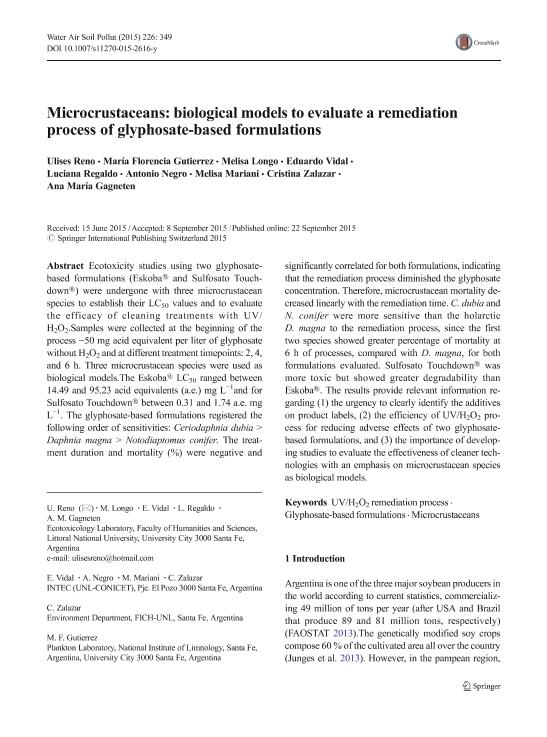Artículo
Microcrustaceans: biological models to evaluate a remediation process of glyphosate-based formulations
Reno, Ulises ; Gutierrez, Marìa Florencia
; Gutierrez, Marìa Florencia ; Longo, Melisa; Vidal, Eduardo Gabriel
; Longo, Melisa; Vidal, Eduardo Gabriel ; Regaldo, Luciana María
; Regaldo, Luciana María ; Negro, Antonio Carlos
; Negro, Antonio Carlos ; Mariani, Melisa Lourdes
; Mariani, Melisa Lourdes ; Zalazar, Cristina Susana
; Zalazar, Cristina Susana ; Gagneten, Ana María
; Gagneten, Ana María
 ; Gutierrez, Marìa Florencia
; Gutierrez, Marìa Florencia ; Longo, Melisa; Vidal, Eduardo Gabriel
; Longo, Melisa; Vidal, Eduardo Gabriel ; Regaldo, Luciana María
; Regaldo, Luciana María ; Negro, Antonio Carlos
; Negro, Antonio Carlos ; Mariani, Melisa Lourdes
; Mariani, Melisa Lourdes ; Zalazar, Cristina Susana
; Zalazar, Cristina Susana ; Gagneten, Ana María
; Gagneten, Ana María
Fecha de publicación:
10/2015
Editorial:
Springer
Revista:
Water, Air And Soil Pollution
ISSN:
0049-6979
Idioma:
Inglés
Tipo de recurso:
Artículo publicado
Clasificación temática:
Resumen
Ecotoxicity studies using two glyphosate-based formulations (Eskoba® and Sulfosato Touchdown®) were undergone with three microcrustacean species to establish their LC50 values and to evaluate the efficacy of cleaning treatments with UV/H2O2.Samples were collected at the beginning of the process −50 mg acid equivalent per liter of glyphosate without H2O2 and at different treatment timepoints: 2, 4, and 6 h. Three microcrustacean species were used as biological models.The Eskoba® LC50 ranged between 14.49 and 95.23 acid equivalents (a.e.) mg L−1and for Sulfosato Touchdown® between 0.31 and 1.74 a.e. mg L−1. The glyphosate-based formulations registered the following order of sensitivities: Ceriodaphnia dubia > Daphnia magna > Notodiaptomus conifer. The treatment duration and mortality (%) were negative and significantly correlated for both formulations, indicating that the remediation process diminished the glyphosate concentration. Therefore, microcrustacean mortality decreased linearly with the remediation time. C. dubia and N. conifer were more sensitive than the holarctic D. magna to the remediation process, since the first two species showed greater percentage of mortality at 6 h of processes, compared with D. magna, for both formulations evaluated. Sulfosato Touchdown® was more toxic but showed greater degradability than Eskoba®. The results provide relevant information regarding (1) the urgency to clearly identify the additives on product labels, (2) the efficiency of UV/H2O2 process for reducing adverse effects of two glyphosate-based formulations, and (3) the importance of developing studies to evaluate the effectiveness of cleaner technologies with an emphasis on microcrustacean species as biological models
Archivos asociados
Licencia
Identificadores
Colecciones
Articulos(CCT - SANTA FE)
Articulos de CTRO.CIENTIFICO TECNOL.CONICET - SANTA FE
Articulos de CTRO.CIENTIFICO TECNOL.CONICET - SANTA FE
Articulos(INTEC)
Articulos de INST.DE DES.TECNOL.PARA LA IND.QUIMICA (I)
Articulos de INST.DE DES.TECNOL.PARA LA IND.QUIMICA (I)
Citación
Reno, Ulises; Gutierrez, Marìa Florencia; Longo, Melisa; Vidal, Eduardo Gabriel; Regaldo, Luciana María; et al.; Microcrustaceans: biological models to evaluate a remediation process of glyphosate-based formulations; Springer; Water, Air And Soil Pollution; 226; 10-2015; 349-359
Compartir
Altmétricas



